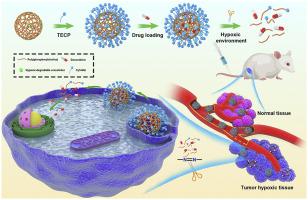Acta Pharmaceutica Sinica B ( IF 14.7 ) Pub Date : 2020-08-26 , DOI: 10.1016/j.apsb.2020.08.012 Shaojun Peng 1, 2 , Boshu Ouyang 3 , Yongjie Xin 1 , Wei Zhao 1 , Shun Shen 4 , Meixiao Zhan 1 , Ligong Lu 1

|
Tumor microenvironment has been widely utilized for advanced drug delivery in recent years, among which hypoxia-responsive drug delivery systems have become the research hotspot. Although hypoxia-responsive micelles or polymersomes have been successfully developed, a type of hypoxia-degradable nanogel has rarely been reported and the advantages of hypoxia-degradable nanogel over other kinds of degradable nanogels in tumor drug delivery remain unclear. Herein, we reported the synthesis of a novel hypoxia-responsive crosslinker and the fabrication of a hypoxia-degradable zwitterionic poly(phosphorylcholine)-based (HPMPC) nanogel for tumor drug delivery. The obtained HPMPC nanogel showed ultra-long blood circulation and desirable immune compatibility, which leads to high and long-lasting accumulation in tumor tissue. Furthermore, HPMPC nanogel could rapidly degrade into oligomers of low molecule weight owing to the degradation of azo bond in hypoxic environment, which leads to the effective release of the loaded drug. Impressively, HPMPC nanogel showed superior tumor inhibition effect both in vitro and in vivo compared to the reduction-responsive phosphorylcholine-based nanogel, owing to the more complete drug release. Overall, the drug-loaded HPMPC nanogel exhibits a pronounced tumor inhibition effect in a humanized subcutaneous liver cancer model with negligible side effects, which showed great potential as nanocarrier for advanced tumor drug delivery.
中文翻译:

缺氧可降解长循环两性离子磷酸胆碱纳米凝胶用于增强肿瘤药物递送
近年来,肿瘤微环境被广泛用于先进的药物递送,其中缺氧反应性药物递送系统已成为研究热点。尽管已经成功开发出缺氧响应性胶束或聚合物囊泡,但一种缺氧可降解纳米凝胶的报道很少,缺氧可降解纳米凝胶相对于其他种类的可降解纳米凝胶在肿瘤药物递送方面的优势尚不清楚。在此,我们报道了一种新型缺氧响应交联剂的合成和一种用于肿瘤药物递送的缺氧可降解两性离子聚(磷酸胆碱)基 ( H PMPC) 纳米凝胶的制备。获得的HPMPC纳米凝胶表现出超长的血液循环和理想的免疫相容性,这导致在肿瘤组织中高度和持久的积累。此外,由于偶氮键在缺氧环境中的降解, H PMPC纳米凝胶可以迅速降解为低分子量的低聚物,从而导致负载药物的有效释放。令人印象深刻的是,与还原反应性磷酸胆碱纳米凝胶相比,H PMPC 纳米凝胶在体外和体内均显示出优异的肿瘤抑制效果,因为药物释放更完全。总体而言,载药HPMPC纳米凝胶在人源化皮下肝癌模型中表现出显着的肿瘤抑制作用,副作用可忽略不计,显示出作为晚期肿瘤药物递送纳米载体的巨大潜力。











































 京公网安备 11010802027423号
京公网安备 11010802027423号